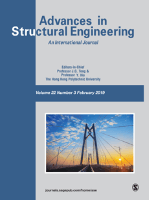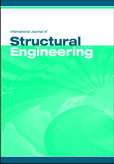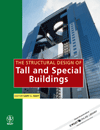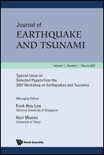
Bulletin of the New Zealand Society for Earthquake Engineering
Scope & Guideline
Advancing earthquake resilience through innovative research.
Introduction
Aims and Scopes
- Seismic Design and Assessment:
The journal emphasizes research on the design and assessment of structures to withstand seismic forces, including guidelines and methodologies that enhance building resilience. - Soil-Structure Interaction:
A core focus is on exploring the interaction between soil and structures during seismic events, which includes modeling techniques and experimental studies that inform design practices. - Innovative Structural Systems:
Research on advanced structural systems, such as base isolation, damping devices, and low-damage designs, is prominent, showcasing innovative solutions to reduce seismic risk. - Risk Assessment and Mitigation:
The journal covers studies related to seismic risk assessment, including loss estimation and the development of consequence functions tailored to New Zealand's unique geological conditions. - Post-Earthquake Recovery and Resilience:
Contributions focusing on post-earthquake recovery strategies and resilience planning highlight the importance of integrating infrastructure resilience in disaster management.
Trending and Emerging
- Machine Learning Applications in Seismic Engineering:
The integration of machine learning techniques to predict seismic performance and assess risks has gained traction, highlighting the potential for data-driven approaches in enhancing earthquake resilience. - Sustainability in Seismic Design:
There is a growing interest in sustainable practices within seismic design, as researchers explore low-damage and environmentally friendly solutions that align with contemporary building standards. - Resilience and Recovery Frameworks:
Emerging themes emphasize the importance of resilience planning and recovery frameworks post-earthquake, reflecting a holistic approach to disaster management and infrastructure resilience. - Advanced Materials and Construction Techniques:
Research into the use of advanced materials, such as ultra-high-strength concrete and innovative reinforcement techniques, is trending, offering new avenues for enhancing structural performance during earthquakes.
Declining or Waning
- Traditional Seismic Analysis Methods:
There has been a noticeable decrease in publications centered on traditional seismic analysis methods, likely due to the growing adoption of advanced computational techniques and performance-based design approaches. - Non-Structural Element Design:
Research specifically addressing the seismic design of non-structural elements seems to be waning, possibly as the focus shifts towards comprehensive building systems rather than isolated components. - Historical Case Studies:
While historical case studies provided valuable insights in the past, there is a decreasing trend in their publication as the emphasis moves towards predictive modeling and real-time analysis of earthquake impacts.
Similar Journals

ADVANCES IN STRUCTURAL ENGINEERING
Advancing the Frontiers of Engineering ResearchADVANCES IN STRUCTURAL ENGINEERING, published by SAGE PUBLICATIONS INC, is a leading journal dedicated to the advancement of knowledge in the fields of Building and Construction, as well as Civil and Structural Engineering. With a solid impact factor and a commendable Scopus ranking (Rank #60 in Building and Construction, Rank #105 in Civil and Structural Engineering), this journal stands at the forefront of academic research, providing a platform for high-quality articles that contribute significantly to the discipline. Covering a range of topics from innovative construction techniques to sustainable engineering practices, the journal aims to foster collaborative dialogue among researchers, industry professionals, and students alike. As of 2023, it boasts impressive category quartiles, ranking Q1 in Building and Construction and Q2 in Civil and Structural Engineering. ADVANCES IN STRUCTURAL ENGINEERING is a vital resource for those looking to stay abreast of emerging trends and groundbreaking developments in structural engineering, promoting an environment of continuous learning and application of best practices. With a convergence of research from 1999 to 2024, the journal not only emphasizes theoretical frameworks but also bridges the gap between academia and practical application in engineering projects.

Ingegneria Sismica
Pioneering knowledge in geotechnical engineering and seismic resilience.Ingegneria Sismica, a premier journal published by PATRON EDITORE S R L, serves as an essential platform for the dissemination of research in the fields of building and construction, geotechnical engineering, and safety risk management. With a focus on earthquake engineering and structural safety, the journal has established itself as a prominent source of knowledge since its inception in 2010. The journal holds an impressive Q2 classification in multiple categories, including Building and Construction and Geotechnical Engineering, reflecting its significant impact within these disciplines. Despite its Italian roots, it appeals to an international audience of researchers, professionals, and students dedicated to advancing the understanding of seismic resilience and risk mitigation strategies. Although open access is not currently available, the potential for knowledge sharing and innovative methodologies presented in the articles continues to attract a robust readership. With its commitment to excellence and relevance, Ingegneria Sismica is poised to shape future discourse in engineering practices aimed at enhancing safety, reliability, and quality within seismic zones.

International Journal of Structural Engineering
Advancing the Frontiers of Structural InnovationInternational Journal of Structural Engineering, published by InderScience Enterprises Ltd, has established itself as a vital resource in the field of civil and structural engineering. With an ISSN of 1758-7328 and an E-ISSN of 1758-7336, this journal is dedicated to disseminating high-quality research that addresses contemporary challenges and innovations in structural engineering. The journal operates under a rigorous peer-review process, ensuring that only the most impactful and relevant studies are shared with the global community. Since its inception in 2009, the journal has been recognized for its contributions, earning a ranking in Q3 for civil and structural engineering under the 2023 Category Quartiles and occupying the 40th percentile in Scopus rankings. While currently not an open-access journal, it provides access to a wide array of original papers, reviews, and case studies that are crucial for fostering academic discourse and supporting the ongoing education of professionals and students alike. As it continues to expand its reach until 2024, the International Journal of Structural Engineering remains a cornerstone for those seeking to enhance their knowledge and practice in the dynamic realm of structural engineering.

International Journal of GEOMATE
Bridging disciplines to enhance understanding in soil science and construction.The International Journal of GEOMATE, published by GEOMATE INT SOC based in Japan, is a pivotal resource for scholars and practitioners in the fields of Building and Construction, Environmental Engineering, Geotechnical Engineering, and Soil Science. Established in 2011 and continuing to set the standard in its focus areas, this journal serves as a platform for innovative research and practical applications, with contributions that significantly enhance the understanding and development of sustainable engineering practices. With its current classification in the Q3 quartile across multiple categories, it strives to disseminate critical knowledge and foster dialogue among a diverse audience, including researchers, industry professionals, and students. Though operating under a traditional subscription model, the journal's emphasis on rigorous peer review and high-quality publications ensures a substantial impact factor, further reinforcing its reputation in academia. Spanning from 2011 to 2024, the International Journal of GEOMATE invites contributions that advance the knowledge frontier and address contemporary challenges in engineering and environmental science.

STRUCTURAL ENGINEERING AND MECHANICS
Bridging Theory and Practice in Structural EngineeringSTRUCTURAL ENGINEERING AND MECHANICS, a leading journal published by TECHNO-PRESS, stands at the forefront of research in the disciplines of civil, structural, and mechanical engineering. With an ISSN of 1225-4568 and an E-ISSN of 1598-6217, this South Korea-based journal has been a significant contributor to the academic community since its inception in 1994, and it continues to disseminate vital research through 2024 and beyond. Achieving a Q3 ranking in key categories such as Building and Construction, Civil and Structural Engineering, Mechanical Engineering, and Mechanics of Materials, the journal is recognized for its high standard of academic rigour and relevance in contemporary engineering challenges. Although not Open Access, it offers robust access options for institutions and professionals seeking to advance their understanding of structural systems and mechanics. Researchers, students, and practitioners in these fields will find invaluable insights and innovative studies that push the boundaries of knowledge, making this journal an essential resource for anyone invested in engineering advancements.

STRUCTURAL DESIGN OF TALL AND SPECIAL BUILDINGS
Advancing Structural Excellence for Complex Designs.STRUCTURAL DESIGN OF TALL AND SPECIAL BUILDINGS is a prestigious journal published by Wiley that focuses on cutting-edge research and advancements in the field of structural engineering, particularly emphasizing tall and special structures. Since its inception in 2003, the journal has become an invaluable resource for academics and practitioners, showcasing innovative design methodologies, case studies, and theoretical contributions. With an ISSN of 1541-7794 and E-ISSN of 1541-7808, this esteemed publication holds impressive Scopus rankings, including Q1 in Architecture, making it a go-to source for the latest developments in engineering related to tall buildings and complex structures. The journal is known not only for its rigorous peer-reviewed articles but also for fostering a collaborative environment among professionals and researchers worldwide. Although it is not an open-access journal, readers from various disciplines, such as architecture, civil and structural engineering, and building construction, will find compelling insights that drive the industry forward. For those committed to excellence in structural design, STRUCTURAL DESIGN OF TALL AND SPECIAL BUILDINGS remains at the forefront of innovation and knowledge dissemination.

Italian Geotechnical Journal-Rivista Italiana di Geotecnica
Elevating Standards in Geotechnical Research and Practice.Italian Geotechnical Journal-Rivista Italiana di Geotecnica, published by PATRON EDITORE S R L, is a rigorously peer-reviewed journal dedicated to advancing the field of geotechnical engineering and engineering geology. With a history dating back to 1976 and an active publication span from 2011 to 2024, the journal provides a vital platform for researchers and practitioners to disseminate innovative findings and methodologies in the field. Although it currently holds a Q4 category ranking in Geotechnical Engineering and Engineering Geology, the journal is committed to maintaining high academic standards and quality of publication. Its Scopus ranking places it within the 29th percentile of Earth and Planetary Sciences, indicating its significance among scholarly publications. The Italian Geotechnical Journal serves not only as a resource for academic inquiry but also as an essential tool for professionals seeking to stay abreast of the latest developments and applications in geotechnical research. This journal is essential for students and researchers aiming to deepen their knowledge and contribute to ongoing discourse in geotechnics.

Journal of Earthquake and Tsunami
Innovating research on earthquakes and tsunamis.Welcome to the Journal of Earthquake and Tsunami, a premier scholarly publication dedicated to advancing the field of geophysical research, with a particular focus on seismic activity and tsunami phenomena. Published by World Scientific Publishing Co Pte Ltd, this journal provides a vibrant platform for researchers and practitioners alike to share their findings and innovations, contributing to the global understanding of these critical natural events. With an impact factor that reflects its relevance, the journal is categorized in Q3 quartiles for 2023 in areas including Geophysics, Geotechnical Engineering, and Oceanography, indicating a solid standing in the scientific community. It is indexed within Scopus, ranking in the upper half of its categories, which further establishes its importance as a resource for students and professionals seeking to stay informed about the latest developments. Although the journal operates under a traditional access model, its commitment to fostering scholarly discourse remains unwavering. Founded in 2008 and set to converge its offerings until 2024, the Journal of Earthquake and Tsunami continues to be an invaluable resource for anyone dedicated to understanding the dynamic and often dangerous interactions of our planet’s geological features.

Periodica Polytechnica-Civil Engineering
Fostering Knowledge for Tomorrow's Engineering ChallengesPeriodica Polytechnica-Civil Engineering is a prestigious journal published by the Budapest University of Technology and Economics, dedicated to advancing the field of civil engineering through high-quality research and innovative practices. Established in 1972, the journal has transitioned through various phases of publication and now spans an expansive range of topics within civil and structural engineering, geotechnical engineering, and engineering geology. With an impact factor indicating its growing influence and a commendable placement in the Q3 quartile according to the latest 2023 metrics, it recognizes contributions that bridge theoretical advancements with practical applications. While currently not open access, the journal remains a vital resource for researchers, professionals, and students seeking to stay abreast of the latest developments in engineering design, construction techniques, and geotechnical innovations. The continuous publication of significant research after almost five decades underscores its commitment to disseminating knowledge crucial for the world’s infrastructure challenges, making it an essential reference point within the engineering community.

Structure and Infrastructure Engineering
Transforming Challenges into Engineering TriumphsStructure and Infrastructure Engineering, published by TAYLOR & FRANCIS LTD, is a premier academic journal that serves as a vital resource in the fields of engineering and construction. Featuring an ISSN of 1573-2479 and an E-ISSN of 1744-8980, this journal has established its reputation as a leader in disseminating high-quality research. Since its inception, it has successfully transitioned through converged years from 2007 to 2024, earning a prestigious position within the Q1 quartile across multiple engineering disciplines, including Building and Construction, Civil and Structural Engineering, and Ocean Engineering, among others. Its impact is underscored by impressive Scopus rankings, particularly its 5th rank in Ocean Engineering within the top 95th percentile. The journal’s commitment to advancing knowledge in safety, risk, reliability, and quality makes it an indispensable platform for researchers, professionals, and students aiming to stay at the forefront of engineering innovations. Access to its comprehensive articles allows for a deeper understanding of contemporary challenges and solutions in infrastructure development.